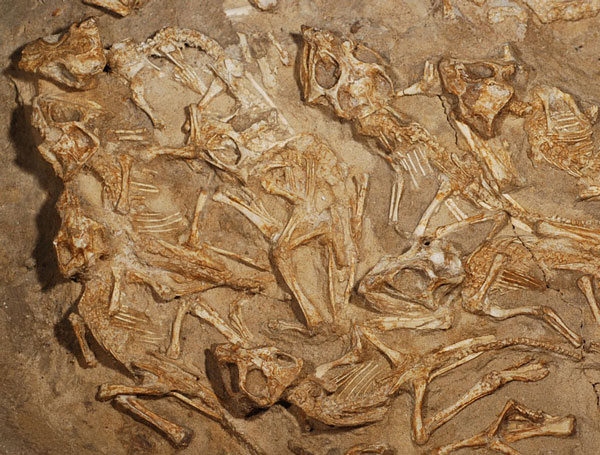Detecting a baby dinosaur nest in Mongolia
Scientists have just discovered the baby dinosaur nest eating plants buried in sand in Mongolia.
According to the Journal of Paleontology , a dinosaur team called Protoceratops andrewsi 70 million years old has just been discovered by 15 immature juvenile dinosaurs.
In a large number of eggs, a link to other dinosaurs like the carnivorous dinosaur Oviraptor or duckbill dinosaurs after discovering a multi-species fossil dinosaur population in the same nest is quite rare.
David Fastovsky, head of the soil research department at Rhode University and colleagues analyzed the newly discovered dinosaur fossils, measuring the diameter of the nest about 60cm.
This fossil dinosaur team was discovered in Tugrikinshire (Mongolia), which is said to be buried sand quickly and has buried these baby dinosaurs while they are still alive.

Detecting fossil bones of the dragon's frame. (Photo: Discovery)
After the research process, the researchers concluded that all 15 dinosaurs have immature characteristics. These dinosaurs have short mouths, large eyes that match and do not have mature traits but have raised horns and have large folds that only mature dinosaurs have.
Based on the analytical samples, the scientists confirmed that the dinosaur population was found to be plant-eating dinosaurs that existed and grew in the nest at least in the early stages of birth.
'Big eggs can be a way to ensure the survival of animals in the natural world because of the care and protection of their parents. Moreover, Mongolia at that time was home to many large carnivorous dinosaurs' hunting 'to eat plant dinosaurs , ' said Mr. Fastovsky.
This dinosaur group is currently being stored at the Paleontological Center of the Mongolian Scientific Research Institute in Ulan Baatar, (Mongolia).
- Detecting the nocturnal egg nest of the dinosaur fetus
- Detecting dozens of zooplankton dinosaur eggs
- Discovered an ancient dinosaur group never seen
- Auction of dinosaur nest
- China has discovered an unprecedented dinosaur egg nest
- Discovering fossils 'swan dinosaurs' is odd in Mongolia
- Discovered giant dinosaur footprints in the Mongolian desert
- Detecting super bird's nest
- Little 3-year-old dinosaur drowned
- Dinosaur skeleton cost 22 billion
- How to use bird's nest is healthy
- Detecting giant dinosaur tails dating back 72 million years
 Discovered an ancient centipede fossil 99 million years old
Discovered an ancient centipede fossil 99 million years old Discovered bat-like dinosaurs in China
Discovered bat-like dinosaurs in China Discovered a 200-year-old bronze cannon of the coast
Discovered a 200-year-old bronze cannon of the coast Discover 305 million-year-old spider fossils
Discover 305 million-year-old spider fossils